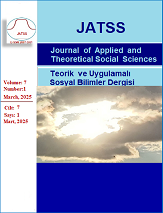From Adam Smith to John Stuart Mill: The Quest for Equilibrium in Classical Economics
Abstract
Introduction: This study examines how the concept of equilibrium evolved in Classical Economics, focusing on prominent thinkers from Adam Smith to John Stuart Mill. The research is important because it sheds light on how foundational economic ideas regarding competition, production, and distribution inform present-day theories and policies.
Method: This study was carried out based on a literature review and theoretical analysis; in addition to the works of the Classical Economists themselves, academic studies and commentaries related to their work and ideas were also utilized.
Results or Findings: The analysis shows that the confidence Smith and Say placed in market mechanisms is significantly constrained by the potential instabilities and the stationary state thesis highlighted by Malthus and Ricardo. Mill’s approach indicates that the economy’s long-term equilibrium is shaped by both income distribution and social norms, while in the short term, actions taken by market participants based on incorrect forecasts or incomplete information can result in disequilibrium.
Discussion or Conclusion: The results imply that Classical Economics presents a rich, nuanced view of equilibrium—one that balances the self-correcting nature of markets with critiques about demand, distribution, and long-run stagnation. These insights remain relevant for contemporary discussions on growth, sustainability, and policy interventions. Future research could compare the classical equilibrium framework with modern theoretical models to explore how historical perspectives continue to shape economic thought and policymaking.
Metrics
References
Akbay, O. S. (2009). Hume’un uluslararası ticarette otomatik akım mekanizması yaklaşımının toplumsal ve felsefi temelleri. Dumlupınar Üniversitesi Sosyal Bilimler Dergisi, 23, 1-6.
Aronoff, D. (2016). The Malthus-Ricardo debate on general glut and secular stagnation. In A Theory of Accumulation and Secular Stagnation: A Malthusian approach to understanding a contemporary malaise (pp. 10-43), Palgrave Pivot. https://doi.org/10.1057/9781137562210_2 DOI: https://doi.org/10.1057/9781137562210_2
Balassa, B. A. (1959). John Stuart Mill and the law of markets. The Quarterly Journal of Economics, 73(2), 263-274. https://doi.org/10.2307/1883724 DOI: https://doi.org/10.2307/1883724
Bannock, G., Baxter, R. E., & Davis E. (1987) Classical economics. In The Penguin dictionary of economics (4th ed., pp. 70-72), Penguin Books.
Baumol, W. J. (1999). Retrospectives: Say's law. Journal of Economic Perspectives, 13(1), 195-204. https://doi.org/10.1257/jep.13.1.195 DOI: https://doi.org/10.1257/jep.13.1.195
Béraud, A., & Numa, G. (2019). Retrospectives Lord Keynes and Mr. Say: A proximity of ideas. Journal of Economic Perspectives, 33(3), 228-242. https://doi.org/10.1257/jep.33.3.228 DOI: https://doi.org/10.1257/jep.33.3.228
Bladen, V. W. (1949). John Stuart Mill’s principles: A centenary estimate. The American Economic Review, 39(3), 2–12. http://www.jstor.org/stable/1831728
Blaug, M. (1997). Say’s Law of Markets: What did it mean and why should we care? Eastern Economic Journal, 23(2), 231–235. http://www.jstor.org/stable/40325773
Brue, S. L. (1993). Retrospectives: The law of diminishing returns. Journal of Economic Perspectives, 7(3), 185-192. https://doi.org/10.1257/jep.7.3.185 DOI: https://doi.org/10.1257/jep.7.3.185
Canterbery, E. R. (1995). The literate economist: A brief history of economics. HarperCollins College Publishers.
Carlyle, T. (1849). Occasional discourse on the negro question. Fraser’s Magazine, 40(240), 670–679.
Chandra, R. (2004). Adam Smith and competitive equilibrium. Evolutionary and Institutional Economics Review, 1(1), 57-83. https://doi.org/10.14441/eier.1.57 DOI: https://doi.org/10.14441/eier.1.57
Claire, O. S. (2013). A key to Ricardo. Routledge. DOI: https://doi.org/10.4324/9781315888934
Clower, R. W. (2004). Trashing J.B. Say: The story of a mare’s nest. In K. V. Velupillai (Ed.), Macroeconomic Theory and Economic Policy (pp. 101-110). Routledge.
Dillard, D. (1953). Ricardo in retrospect. The Journal of Economic History, 13(1), 94-101. https://doi.org/10.1017/S002205070007008X DOI: https://doi.org/10.1017/S002205070007008X
Dixon, R. (2006). Carlyle, Malthus and Sismondi: The origins of Carlyle’s dismal view of political economy. History of Economics Review, 44(1), 32–38. https://doi.org/10.1080/18386318.2006.11681227 DOI: https://doi.org/10.1080/18386318.2006.11681227
Dorfman, R. (1989). Thomas Robert Malthus and David Ricardo. Journal of Economic Perspectives, 3(3), 153-164. http://doi.org/10.1257/jep.3.3.153 DOI: https://doi.org/10.1257/jep.3.3.153
Evans Jr, G. H. (1967). The law of demand—The roles of Gregory King and Charles Davenant. The Quarterly Journal of Economics, 81(3), 483-492. https://doi.org/10.2307/1884813 DOI: https://doi.org/10.2307/1884813
Fernández-Villaverde, J. (2001, December 16). Was Malthus right? Economic growth and population dynamics (PIER Working Paper No.01-046). Penn Institute for Economic Research. http://dx.doi.org/10.2139/ssrn.293800 DOI: https://doi.org/10.2139/ssrn.293800
Hume, D. (1752). Political discourses. R. Fleming.
Jonsson, P. O. (1995). On the economics of Say and Keynes’ interpretation of Say’s Law. Eastern Economic Journal, 21(2), 147–155. http://www.jstor.org/stable/40325627
Kates, S. (1997). On the true meaning of Say’s Law. Eastern Economic Journal, 23(2), 191–202. http://www.jstor.org/stable/40325770
Kazgan, G. (2014). İktisadi düşünce veya politik iktisadın evrimi. On dokuzuncu basım. Remzi Kitabevi.
Kurer, O. (1989). John Stuart Mill on government intervention. History of Political Thought, 10(3), 457–480. http://www.jstor.org/stable/44797145
Levy, M. B. (1981). Mill’s Stationary State & the Transcendance of Liberalism. Polity, 14(2), 273–293. https://doi.org/10.2307/3234548 DOI: https://doi.org/10.2307/3234548
Madsen, J. B., Robertson, P. E., & Ye, L. (2019). Malthus was right: Explaining a millennium of stagnation. European Economic Review, 118, 51-68. https://doi.org/10.1016/j.euroecorev.2019.05.004 DOI: https://doi.org/10.1016/j.euroecorev.2019.05.004
Malthus, T. R. (1798). An essay on the principle of population, as it affects the future improvement of society, with remarks on the speculations of Mr. Godwin, M. Condorcet, and other writers. 1st edition. J. Johnson. https://oll.libertyfund.org/titles/malthus-an-essay-on-the-principle-of-population-1798-1st-ed
Malthus, T. R. (1989). Principles of political economy. Cambridge University Press. (Original work published 1820)
Malthus, T. R. (2018). An essay on the principle of population: The 1803 edition. Yale University Press. (Original work published 1803) DOI: https://doi.org/10.12987/9780300231892
McGee, R. W. (1989). The economic thought of David Hume. Hume Studies, 15(1), 184-204. https://doi.org/10.1353/hms.2011.0475 DOI: https://doi.org/10.1353/hms.2011.0475
Mill, J. S. (1909). Principles of Political Economy with some of their Applications to Social Philosophy, 7th ed., ed. William James Ashley, Longmans, Green and Co. (Original first edition published 1848) https://oll.libertyfund.org/titles/mill-principles-of-political-economy-ashley-ed
Myers, M. L. (1976). Adam Smith’s concept of equilibrium. Journal of Economic Issues, 10(3), 560-575. https://doi.org/10.1080/00213624.1976.11503361 DOI: https://doi.org/10.1080/00213624.1976.11503361
O’Connor, M. (1997). John Stuart Mill’s utilitarianism and the social ethics of sustainable development. The European Journal of the History of Economic Thought, 4(3), 478–506. https://doi.org/10.1080/10427719700000063 DOI: https://doi.org/10.1080/10427719700000063
O'Leary, J. J. (1942). Malthus and Keynes. Journal of Political Economy, 50(6), 901-919. https://doi.org/10.1086/255968 DOI: https://doi.org/10.1086/255968
Otteson, J. (2018). The essential Adam Smith. Fraser Institute.
Pancoast, O. (1943). Malthus versus Ricardo: the effects of distribution on production. Political Science Quarterly, 58(1), 47-66. https://doi.org/10.2307/2144427 DOI: https://doi.org/10.2307/2144427
Pullen, J. M. (2001). Keynes’s Criticisms of Malthus, and ‘Malthus’s Reply’: the Concept of Effective Supply, History of Economics Review, 34(1), 168-181. https://doi.org/10.1080/10370196.2001.11733364 DOI: https://doi.org/10.1080/10370196.2001.11733364
Rankin, S. C. (1980). Supply and demand in Ricardian price theory: a re-interpretation. Oxford Economic Papers, 32(2), 241-262. https://doi.org/10.1093/oxfordjournals.oep.a041478 DOI: https://doi.org/10.1093/oxfordjournals.oep.a041478
Ricardo, D. (2001). The principles of political economy and taxation, Batoche Books. (Original work published 1817)
Robbins (1967) Malthus as an economist. The Economic Journal, 77(306), 256–261. https://doi.org/10.2307/2229303 DOI: https://doi.org/10.2307/2229303
Savaş, V. F. (2000). İktisatın Tarihi. 4. Baskı. Siyasal Yayınevi.
Sharp, P., Strulik, H., & Weisdorf, J. (2012). The determinants of income in a Malthusian equilibrium. Journal of Development Economics, 97(1), 112-117. https://doi.org/10.1016/j.jdeveco.2010.12.004 DOI: https://doi.org/10.1016/j.jdeveco.2010.12.004
Skinner, A. S. (1967). Say's law: Origins and content. Economica, 34(134), 153-166. https://doi.org/10.2307/2552481 DOI: https://doi.org/10.2307/2552481
Skousen, M. (2022). The making of modern economics: The lives and ideas of great thinkers. (4th ed.). Routledge. DOI: https://doi.org/10.4324/9781003192954
Smith, A. (2010). The theory of moral sentiments. Penguin. (Original work published 1759) DOI: https://doi.org/10.1093/oseo/instance.00042831
Smith, A. (2013). The wealth of nations. Create Space Independent Publishing. (Original work published 1776)
Sowell, T. (1963). The general glut controversy reconsidered. Oxford Economic Papers, 15(3), 193-203. https://doi.org/10.1093/oxfordjournals.oep.a040924 DOI: https://doi.org/10.1093/oxfordjournals.oep.a040924
Spiegel, H. W. (1991). The growth of economic thought. Duke University Press.
Stigler, G. J. (1952). The Ricardian theory of value and distribution. Journal of Political Economy, 60(3), 187-207. https://doi.org/10.1086/257208 DOI: https://doi.org/10.1086/257208
Tucker, G. S. L. (1961). Ricardo and Marx. Economica, 28(111), 252-269. https://doi.org/10.2307/2601601 DOI: https://doi.org/10.2307/2601601
Wrigley, E. A. (1988). The limits to growth: Malthus and the classical economists. Population and Development Review, 14, 30-48. https://doi.org/10.2307/2808089 DOI: https://doi.org/10.2307/2808089






















